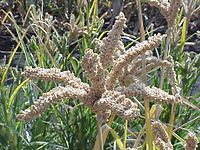
Photo from wikipedia
Maize (Zea mays L.), an important food and feed crop worldwide, can be infected by Fusarium pathogens that can contaminate grain with mycotoxins. From August to October in 2018 and… Click to show full abstract
Maize (Zea mays L.), an important food and feed crop worldwide, can be infected by Fusarium pathogens that can contaminate grain with mycotoxins. From August to October in 2018 and 2019, a field survey for maize ear rot was conducted in 76 counties of Guizhou province. The incidence ranged from 3% to 15% at individual fields in different areas. A total of 175 diseased maize ears with similar symptoms, including kernels covered with white, pink or salmon-colored mold or exhibiting a white streaking ("starburst") symptom, were collected from fields. Symptomatic kernels were surface-sterilized by soaking for 30 s in 70% alcohol and for another 2 min in 2% sodium hypochlorite solution, followed by five rinses with sterile water. Each kernel was cut into half and placed on potato dextrose agar (PDA). After incubation at 28 °C in the dark for 5 days, colonies displaying morphological characteristics of Fusarium were transferred to fresh PDA (Leslie and Summerell 2006). Single-sporing was conducted to purify the putative Fusarium colonies. A total of 120 isolates belonged to 16 Fusarium species were determined and F. meridionale was the dominant species. Five isolates from Huaxi district of Guiyang City were identified as F. miscanthi (Gams et al. 1999). Colonies on PDA were white and floccose, and pigmentation as viewed from the underside of the Petri dish was violet. The average growth rate was 7.5-8.0 mm/day at 28 °C in the dark. In cultures grown on PDA, 0-1-septate microconidia were produced in slimy heads. Microconidia were clavate to fusiform with a truncate base and a broadly rounded tip, 4.8-13.3 μm × 1.8-3.3 μm (n=110). In cultures grown on half-strength CMC broth (Xu et al. 2010), macroconidia were mostly 3-septate, almost straight for most of the length, with a slightly foot-shaped basal cell and curved apical cell that gradually tapered, 17.8-71.3 μm × 2.0-4.3 μm (n=78). The identity of the fungus was confirmed by sequence comparison of the partial translation elongation factor-1α (TEF-1α), RNA polymerase II subunit (RPB2), mitochondrial small subunit rDNA (mtSSU) and β-tubulin genes (Mirete et al. 2004; O'Donnell et al. 2010; O'Donnell and Cigelnik 1997). BLASTn searches of GenBank, using the partial TEF-1α (MN750829), RPB2 (MN750834), mtSSU (MT594104) and β-tubulin (MT584781) sequences of representative isolate GYHXB03 as the queries, revealed 99.84%, 99%, 100% and 100% sequence identity, respectively, to F. miscanthi NRRL 26231 accessions AF324331, JX171634, AF060371 and AF060384. Inoculum of isolate GYHXB03 was prepared (Xu et al. 2010), and a pathogenicity test was conducted on maize hybrid "Shundan7" and repeated twice. A 106/mL spore suspension (2 mL) or sterile water was injected into each of 8 maize ears through the silk channel at the blister stage of reproductive development in field (Duan et al. 2019). After three weeks, typical Fusarium kernel rot symptoms the same as those previously shown in the field was observed on all pathogen-inoculated plants, while the controls were asymptomatic. The pathogens re-isolated from two diseased kernels were identified as F. miscanthi based on morphology and TEF-1α and mtSSU analyses. F. miscanthi was first isolated from Miscanthus sinensis in Denmark (Gams et al. 1999), and also identified from M. × giganteus rhizomes in Belgium (Scauflaire et al. 2013). To our knowledge, this is the first report of F. miscanthi causing maize ear rot in China. This disease should be monitored in Guizhou due to its threat to maize production.
Journal Title: Plant disease
Year Published: 2020
Link to full text (if available)
Share on Social Media: Sign Up to like & get
recommendations!